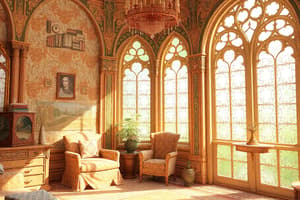Podcast
Questions and Answers
Which 2D animation software is primarily open-source and utilizes vector graphics?
Which 2D animation software is primarily open-source and utilizes vector graphics?
- Toon Boom Harmony
- Pencil2D
- Synfig Studio (correct)
- Adobe Animate
What is a key feature of Autodesk Maya?
What is a key feature of Autodesk Maya?
- Focused solely on motion graphics
- Primarily used for traditional hand-drawn animation
- User-friendly interface for beginners
- Comprehensive 3D modeling, animation, and rendering capabilities (correct)
Which of the following is NOT a design element in character design?
Which of the following is NOT a design element in character design?
- Style Consistency
- Frame Rate (correct)
- Silhouette
- Color Palette
Which technique involves tracing over live-action footage to create realistic motion?
Which technique involves tracing over live-action footage to create realistic motion?
What is the purpose of model sheets in character design?
What is the purpose of model sheets in character design?
Which software is best known for its use in motion graphics?
Which software is best known for its use in motion graphics?
What does rigging in 3D animation entail?
What does rigging in 3D animation entail?
Which of the following describes the cut-out animation technique?
Which of the following describes the cut-out animation technique?
Flashcards are hidden until you start studying
Study Notes
Software Tools
-
2D Animation Software:
- Adobe Animate: Vector-based, suitable for web and interactive animations.
- Toon Boom Harmony: Industry-standard for 2D animation, offers robust features for frame-by-frame and cut-out animation.
- Synfig Studio: Open-source, utilizes vector graphics for 2D animations.
- Pencil2D: User-friendly, open-source tool for traditional hand-drawn animations.
-
3D Animation Software:
- Autodesk Maya: Comprehensive 3D modeling, animation, and rendering software widely used in film and gaming.
- Blender: Open-source, powerful tool with capabilities for modeling, animation, and rendering.
- Cinema 4D: Known for motion graphics, offers intuitive interface and powerful tools for 3D animation.
- ZBrush: Primarily used for sculpting detailed 3D models, often integrated into animation workflows.
Character Design
-
Concept Development:
- Research and gather inspiration from various sources (art, nature, culture).
- Create character profiles outlining personality, backstory, and traits.
-
Design Elements:
- Silhouette: Ensure strong and recognizable outlines for easy identification.
- Color Palette: Choose colors that reflect the character’s personality and mood.
- Style Consistency: Maintain a consistent art style that aligns with the animation's overall aesthetic.
-
Model Sheets:
- Develop model sheets showcasing different angles and poses of the character.
- Include facial expressions and key poses to guide animators.
Animation Techniques
-
2D Animation Techniques:
- Frame-by-Frame Animation: Draw each frame individually, creating a fluid motion.
- Cut-Out Animation: Use digital puppets and manipulate parts for movement.
- Rotoscoping: Trace over live-action footage to create realistic motion.
-
3D Animation Techniques:
- Keyframe Animation: Set key poses and allow software to interpolate between them.
- Rigging: Create a skeleton structure for 3D models to enable movement.
- Motion Capture: Record live performances to create realistic animations.
-
Principles of Animation:
- Squash and Stretch: Adds a sense of weight and flexibility.
- Anticipation: Prepares the audience for an action.
- Timing and Spacing: Controls the speed and rhythm of movement.
- Follow Through and Overlapping Action: Creates realism by allowing parts of the character to move at different rates.
Software Tools
-
2D Animation Software:
- Adobe Animate: Vector-based platform ideal for web and interactive animations.
- Toon Boom Harmony: Recognized as the industry standard, supports frame-by-frame and cut-out techniques.
- Synfig Studio: Open-source option that employs vector graphics for creating 2D animations.
- Pencil2D: Intuitive and user-friendly open-source software designed for traditional hand-drawn animation.
-
3D Animation Software:
- Autodesk Maya: A comprehensive tool for 3D modeling, animation, and rendering, widely used in the film and gaming industries.
- Blender: Powerful open-source software that offers extensive modeling, animation, and rendering capabilities.
- Cinema 4D: Notable for its motion graphics, featuring an intuitive interface alongside powerful tools for 3D animation.
- ZBrush: Focused on sculpting detailed 3D models, usually integrated into larger animation workflows.
Character Design
-
Concept Development:
- Conduct thorough research and gather inspiration from diverse areas such as art, nature, and culture.
- Develop detailed character profiles that define personality traits, backstory, and behavioral patterns.
-
Design Elements:
- Silhouette: Ensure characters have strong, recognizable outlines for easy identification among viewers.
- Color Palette: Select colors that effectively convey the character's personality and emotional state.
- Style Consistency: Maintain a uniform art style that aligns with the overall aesthetic of the animation project.
-
Model Sheets:
- Create model sheets that illustrate the character from various angles and poses to help guide animators.
- Include facial expressions and essential poses to facilitate consistent character representation throughout the animation.
Animation Techniques
-
2D Animation Techniques:
- Frame-by-Frame Animation: Involves drawing each frame individually, leading to smooth and fluid motion.
- Cut-Out Animation: Utilizes digital puppetry by manipulating movable parts for animation sequences.
- Rotoscoping: Involves tracing over live-action footage to achieve realistic movement in animations.
-
3D Animation Techniques:
- Keyframe Animation: Establishes key poses for characters, with software interpolating the motion in between.
- Rigging: Involves creating a skeletal structure for 3D models to allow for realistic movement.
- Motion Capture: Records live performances to produce authentic and lifelike animations.
-
Principles of Animation:
- Squash and Stretch: Introduces a sense of weight and flexibility to animated objects or characters.
- Anticipation: Prepares the audience for subsequent actions, making animations more engaging.
- Timing and Spacing: Governs the speed and rhythm of movements, contributing to visual dynamics.
- Follow Through and Overlapping Action: Enhances realism by allowing different parts of a character or object to move at varying speeds.
Studying That Suits You
Use AI to generate personalized quizzes and flashcards to suit your learning preferences.




